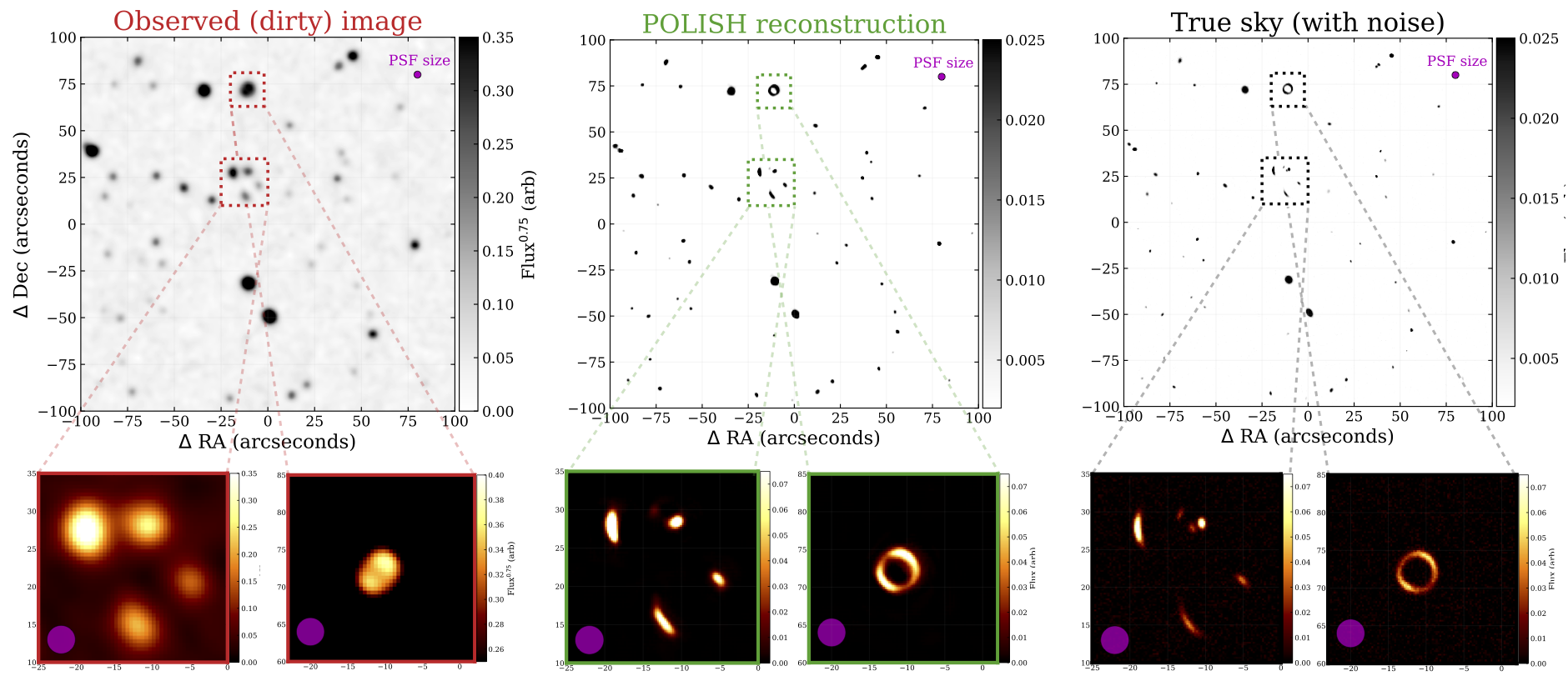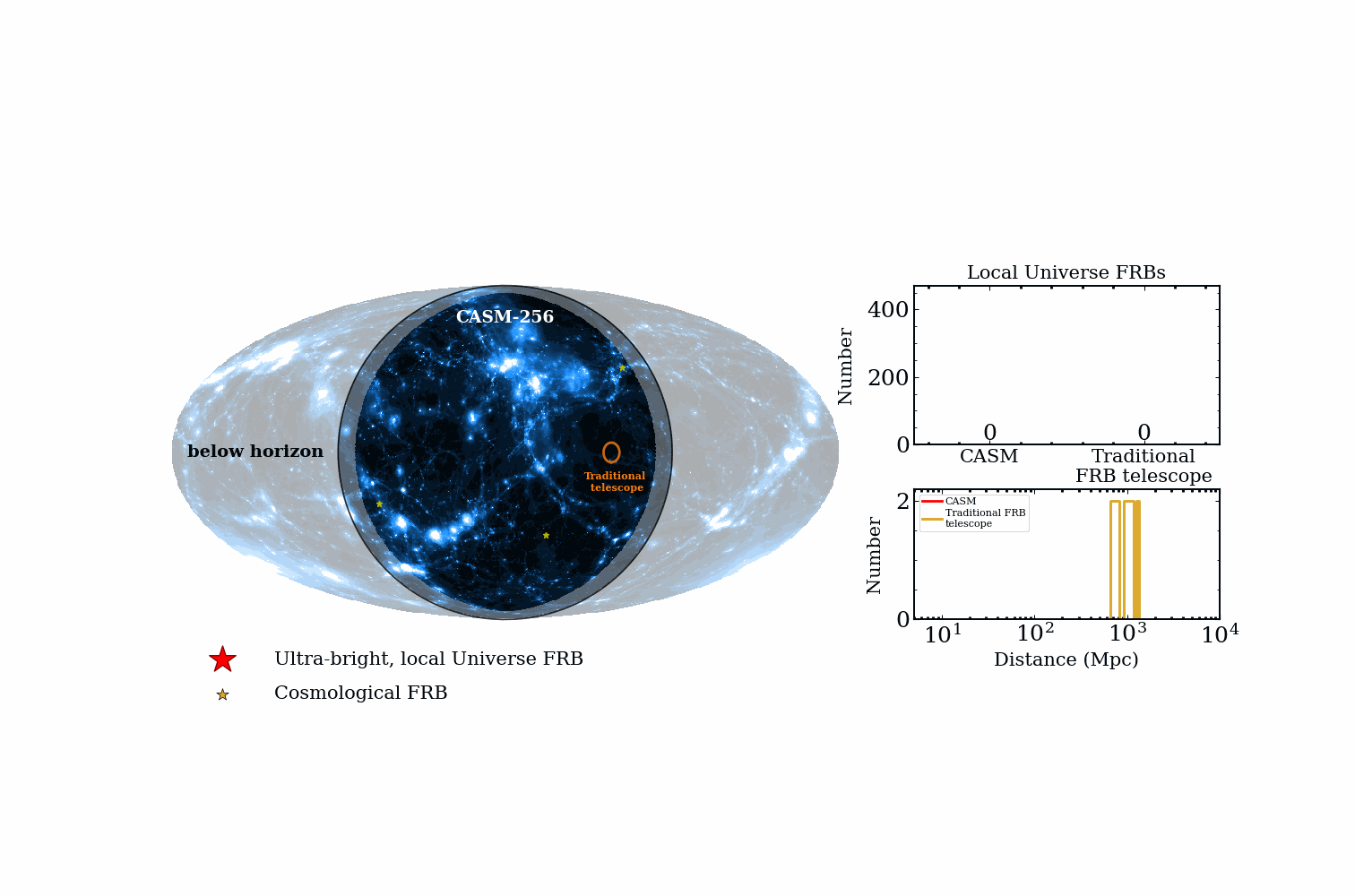Fast Radio Bursts (FRBs)
FRBs are pulses of radio waves that come from the distant Universe. They typically last for just a millisecond, but can be as short at ~ten microseconds and as long as a second. I study their origins and potential as cosmological probes. Specifically, I am interested in using the dispersion of FRBs to map out the Universe's baryon cosmic web, the exact distribution of which has a significant impact on galaxy formation and precision cosmology.
The animation on the right shows an FRB travelling through the IllustrisTNG simulation and the corresponding dispersion measure from ionized plasma in the baryon cosmic web. After ~20 seconds the pulses passes through a massive galaxy cluster, rapidly boosting its dispersion measure. Feel free to use it!
Hardware: Coherent All-Sky Monitor (CASM)
We have begun to build a "dense aperture array" to search 10,000 square degrees for transient radio phenomena. We call this telescope CASM or the Coherent All-Sky Monitor. The Pathfinder instrument will be made of 256 printed circuit board (PCB) dipoles at the Owens Valley Radio Observatory (OVRO). By doing away with dishes, our dipoles can "see" nearly the whole visible sky simultaneously. This will eventually allow us to detect strongly lensed FRBs, coherent emission coincident with gravitational wave events, and Galactic magnetars. CASM will find the brighest, nearest extragalactic FRBs, allowing us to study in detail the FRB phenomenon in our backyard.
Surveys: The DSA-110
The DSA-110 is an array of 5 m dishes at Caltech's Owens Valley Radio Observatory (OVRO) that was built with the express purpose of discovering FRBs and localizing them to their host galaxies. Since 2022, we have amassed a significant sample of localized FRBs, which we follow up with optical and infrared instruments at the W. M. Keck Observatory and Palomar Observatory. Studying this sample has led to some fascinating results and continues to be great fun!

Surveys: The DSA-2000
The DSA-2000 takes the small-dish, many antennas paradigm to its extreme. This planned telescope will be the most powerful radio array ever constructed when it sees first light. While its predecessor (DSA-110) had a focused goal of localizing FRBs, the DSA-2000 is a broad survey instrument that will map everything above Dec -30 down to 500 nJy, discover large swaths of new pulsars and FRBs, detect nanoHz gravitational waves, and much more.

AI/ML: Superresolution and interferometric deconvolution
Imaging the sky with an interferometric array of radio antennas requires solving an ill-posed inverse problem known as deconvolution. Significant progress has been made recently by the computer vision community on a similar class of problems, using efficient neural network architectures. My colleagues and I have developed these tools for superresolution imaging in radio astronomy, which will enable telescopes like the DSA-2000 to find hundreds of thousand of strong gravitational lenses that would otherwise be too blurry to detect.

AI/ML: 3D reconstruction of the cosmic web
I am interested in using modern machine learning techniques to reconstruct cosmological 3D fields from astronomical observations. This includes a collaboration with the Caltech computational cameras group and Google Research that seeks to reconstruct the intervening dark matter field causing weak lensing of distant galaxies. I am also in the early stages of studying how to do this for the baryon cosmic web, which traces the dark matter large-scale structure but deviates in important ways at small scales.
Hardware: Galactic Radio eXplorer (GReX)
My collaborators and I have built the Global Radio eXplorer (GReX , rhymes with "T-Rex") as an international all-sky monitor that will continuously survey the Galaxy for ultrabright bursts at 1.4 GHz with ~10 microsecond time resolution. Clusters of three radio antennas will be placed around the world in order to find more Galactic FRBs, super giant pulses from pulsars, and whatever unknown phenomena occupies this underexplored volume of parameter space. Thus far, we have sent GReX terminals to OVRO, Cornell, Harvard, Hat Creek Observatory, Ireland, and Australia.

